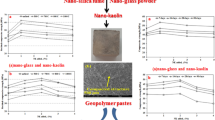Abstract
Formations and durabilities of hydrated layers were compared between a soda-aluminosilicate (NAS), a soda-lime-aluminosilicate(NCAS) and a soda-lime-alumino-borosilicate(NCABS) glasses. The first step of our study was to prepare the optically transparent hydrated layers on the surface of specimens by an autoclave(400 °C, 20 kgf/cm2) treatment. Distributions of OH groups in hydrated layers were analyzed by an etch sectioning and FTIR measurement. The rates of hydration of the glasses were in the order NAS”NCAS>NCABS. The hydration of the NCABS glass, which is a modified nuclear waste glass, required the treatment longer than those of the NAS and NCAS glasses. In the second step, we investigated the durabilities of hydrated layers by immersing the specimens into a distilled water at 100 °C. The dissolutions of hydrated layers were confirmed for each glass. The dissolution rates of hydrated layers were in the order NCAS>NCABS”NAS. It has become apparent by an XPS analysis that the highest durability of the hydrated NAS glass was due to the formation of a sodium free Al2O3-SiO2 layer on the surface. The hydrated layer of the NCAS glass, while the sodium ions were almost leached out during immersion, dissolved to water most quickly than those of other glasses. In the hydrated layer of the NCABS glass, a half amount of sodium and boron ions remained and inhibited the dissolution of hydrated layer.
Similar content being viewed by others
References
B.C. Bunker and G.W. Arnold, Mat.Res.Soc.Symp.Proc., 15, 151 (1983).
J.K. Bates and M.J. Steindler, Mat.Res.Soc.Symp.Proc., 15, 83 (1983).
I. Friedman and W. Long, Science, 191 (1976) 347.
C.D. Byers, M.J. Jercinovic, R.C. Ewing and K. Keil, Mat.Res.Soc.Symp.Proc., 44, 583 (1985).
W.A. Lanford, Science, 196, 975 (1977).
D.E. Clark and L.L. Hench, Mat.Res.Soc.Symp.Proc., 15, 113 (1983).
R.F. Bartholomew, Treatise on Materials Science and Technology, Vol.22, p.75, Edited by M. Tomozawa and R.H. Doremus, Academic Press, New York 1982.
F.M. Ernsberger, J.Am.Ceram.Soc., 60, 91 (1977).
H. Scholze, Glastech.Ber, 32, 142 (1959).
W.A. Lanford, K. Davis, P. Lamarche, T. Laursen, R. Groleau and R.H. Doremus, J.Non-Cryst.Solids, 33, 249 (1979).
R.H. Dremus, Treatise on Materials Science and Technology, Vol.17, p.75, Edited by M. Tomozawa and R.H. Doremus, Academic Press, New York 1979.
D.E. Day and G.E. Rindone, J.Am.Ceram.Soc., 45, 489 (1962).
Author information
Authors and Affiliations
Rights and permissions
About this article
Cite this article
Nishii, J., Akai, T., Yamashita, M. et al. Formation and Durability of Hydrated Layers for Several Oxide Glasses. MRS Online Proceedings Library 353, 47–54 (1994). https://doi.org/10.1557/PROC-353-47
Published:
Issue Date:
DOI: https://doi.org/10.1557/PROC-353-47




